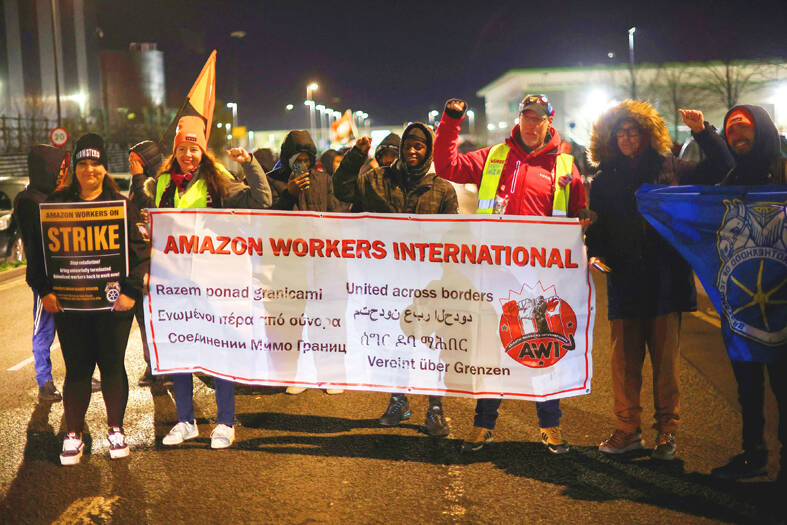Amazon.com Inc workers came out on strike at multiple locations across Europe yesterday as protests against the US e-commerce giant’s working practices picked up pace on one of the busiest shopping days of the year.
“Make Amazon Pay,” a global campaign coordinated by the UNI Global Union, said strikes and protests would take place in more than 30 countries from so-called “Black Friday” through Monday.
Many retailers slash prices to boost sales on Black Friday, the day after the US Thanksgiving holiday.

Photo: Reuters
Originally known for crowds lining up at big-box stores in the US, the event has increasingly moved online and gone global, fueled in part by Amazon, which advertises 10 days of holiday discounts this year from Friday last week to Monday next week.
In Germany, Amazon’s second-biggest market by sales last year, workers at five fulfillment centers in Bad Hersfeld, Dortmund, Koblenz, Leipzig and Rheinberg started a 24-hour strike at midnight on Thursday to demand a collective wage agreement, trade union Verdi said.
An Amazon spokesperson in Germany said workers are paid fair wages, with a starting salary of more than 14 euros (US$15.27) an hour, and have additional benefits. The spokesperson said deliveries of Black Friday orders would be reliable and timely.
More than 200 workers were striking yesterday at Amazon’s warehouse in Coventry, England as part of a long-running dispute over pay.
Nick Henderson, a worker at the Coventry warehouse, which acts as a logistics hub for Amazon to process products to send to other warehouses, said he was striking for higher pay and better working conditions.
The striking workers were chanting their demand for a pay rise to £15 (US$18.69) an hour.
An Amazon UK spokesperson said minimum starting pay is between £11.80 and £13 an hour depending on location, and would increase to £12.30 to £13 an hour from April next year. Amazon said the strike would not cause disruption.
Italian trade union CGIL called for a Black Friday strike at the Castel San Giovanni warehouse, while Spanish union CCOO called for Amazon warehouse and delivery workers to stage a one-hour strike on each shift on “Cyber Monday,” the last day of Amazon’s 10-day sale.
Amazon’s parcel lockers — located in train stations, supermarket car parks and street corners, and used by many customers to receive orders — are also being targeted.
In France, anti-globalization organization Attac is encouraging activists to plaster them with posters and ticker tape, potentially blocking delivery workers and customers from being able to open them.
Attac, which calls Black Friday a “celebration of overproduction and overconsumption,” said it expects the protest to be wider than last year, when it estimates 100 Amazon lockers across France were targeted.
Amazon has remained popular in Europe even as rivals such as Shein and Temu have seen rapid growth. Amazon’s app had 146 million active users in Europe last month, compared to 64 million for Shein and 51 million for Temu, data.ai’s data shows.

The US dollar was trading at NT$29.7 at 10am today on the Taipei Foreign Exchange, as the New Taiwan dollar gained NT$1.364 from the previous close last week. The NT dollar continued to rise today, after surging 3.07 percent on Friday. After opening at NT$30.91, the NT dollar gained more than NT$1 in just 15 minutes, briefly passing the NT$30 mark. Before the US Department of the Treasury's semi-annual currency report came out, expectations that the NT dollar would keep rising were already building. The NT dollar on Friday closed at NT$31.064, up by NT$0.953 — a 3.07 percent single-day gain. Today,

‘SHORT TERM’: The local currency would likely remain strong in the near term, driven by anticipated US trade pressure, capital inflows and expectations of a US Fed rate cut The US dollar is expected to fall below NT$30 in the near term, as traders anticipate increased pressure from Washington for Taiwan to allow the New Taiwan dollar to appreciate, Cathay United Bank (國泰世華銀行) chief economist Lin Chi-chao (林啟超) said. Following a sharp drop in the greenback against the NT dollar on Friday, Lin told the Central News Agency that the local currency is likely to remain strong in the short term, driven in part by market psychology surrounding anticipated US policy pressure. On Friday, the US dollar fell NT$0.953, or 3.07 percent, closing at NT$31.064 — its lowest level since Jan.

Hong Kong authorities ramped up sales of the local dollar as the greenback’s slide threatened the foreign-exchange peg. The Hong Kong Monetary Authority (HKMA) sold a record HK$60.5 billion (US$7.8 billion) of the city’s currency, according to an alert sent on its Bloomberg page yesterday in Asia, after it tested the upper end of its trading band. That added to the HK$56.1 billion of sales versus the greenback since Friday. The rapid intervention signals efforts from the city’s authorities to limit the local currency’s moves within its HK$7.75 to HK$7.85 per US dollar trading band. Heavy sales of the local dollar by

The Financial Supervisory Commission (FSC) yesterday met with some of the nation’s largest insurance companies as a skyrocketing New Taiwan dollar piles pressure on their hundreds of billions of dollars in US bond investments. The commission has asked some life insurance firms, among the biggest Asian holders of US debt, to discuss how the rapidly strengthening NT dollar has impacted their operations, people familiar with the matter said. The meeting took place as the NT dollar jumped as much as 5 percent yesterday, its biggest intraday gain in more than three decades. The local currency surged as exporters rushed to